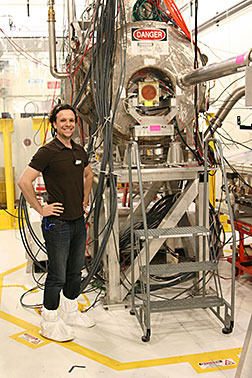- Number 409 |
- March 17, 2014
Fermilab’s Bowring helps spark new designs for accelerators

Daniel Bowring stands next to a magnet
in the MuCool Test Area at Fermilab.
Photo by Yagmur Torun, Fermilab.
Daniel Bowring once considered himself a traveling scientist. He’s worked at two national labs almost 3,000 miles apart on separate coasts. Now, Bowring calls DOE’s Fermi National Accelerator Laboratory home.
The time wandering was well-spent, he said. His college, graduate and post-doctoral experiences at Berkeley Lab and Jefferson Lab helped him realize where he fit in the physics community – accelerator science.
Bowring was awarded a Peoples Fellowship last year, a position for promising early-career accelerator researchers. He began work at Fermilab in October 2013.
The fellowship gives him the chance to develop new particle accelerator technology. Some days, Bowring types away at a keyboard and churns through computer simulations. On other days, he tinkers with gadgets.
“I really enjoy both messing with math and swinging a wrench,” Bowring said.
His current research interest lies in normal conducting accelerator cavities. These are hollow copper structures used in accelerators to speed up particles.
Right now, Bowring is trying to solve both a physics and an engineering puzzle. In accelerators, the cavities first speed up the particles, and then magnets focus and steer them. Bowring is working on designs for accelerators that require operating the cavities inside strong magnets, so speeding up and focusing particles occurs all at once.
The cavities are powered by electric fields that oscillate at radio frequencies, and a big challenge is radiofrequency breakdown. This happens when the cavity voltage collapses, causing sparks roughly resembling lightning strikes. The sparks leave craters and pits on the surface of the copper cavity. And when you place the cavity within a strong magnetic field, you get even more sparks.
In some cases, the damage doesn’t change how the machine performs. But in others, it causes problems. Researchers aren’t exactly sure why.
Bowring is interested in accelerator designs that require very rapid, efficient acceleration. But RF breakdown can limit the voltage you are able to apply in an accelerator. Less voltage means less acceleration, which leads to slower moving particles.
“The quicker we can get the particles up to speed, the quicker we can start doing useful things with them. This is especially important for short-lived particles,” Bowring said. “Imagine you're drag racing and you need to make it to the finish line in under four seconds. Would you rather drive my sedan or an eight-cylinder Maserati?”
Scientists dream of creating colliders that use particles other than protons and electrons. Bowring’s research could boost muons – electrons’ heavy cousins, which exist only for a fraction of a second – up to speed more quickly. At low speeds, some muons decay before physicists can make them collide. The solution to the RF breakdown problem would have applications for next-generation accelerators and beyond.
“I enjoy this type of research because there’s a narrative arc that extends well into the future,” Bowring said. “My colleagues and I are trying to push the boundaries of what is possible with particle accelerator technology.” – by Amanda SollidaySubmitted by DOE's Fermi National Accelerator Laboratory
